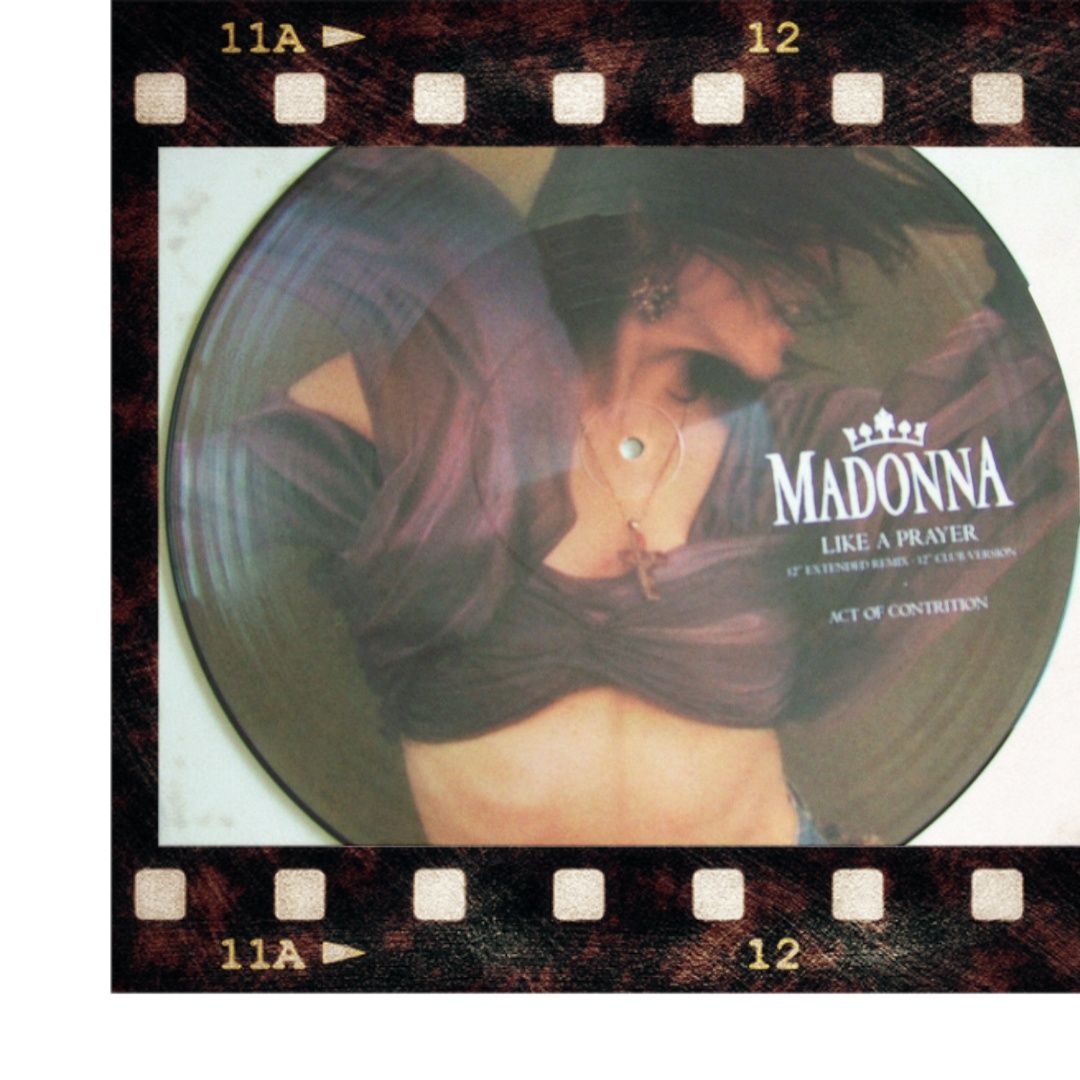FEBRUARY 23, 1989
THAT DAY ................................The video ‘LIKE PRAYER » by Madonna debuted on MTV
Madonna is no stranger to controversy. Over the course of her long career, she’s frequently pushed boundaries — and raised eyebrows — with her risqué performances, videos, and lyrics. One of the biggest scandals came in 1989, when she released her video for the song “Like a Prayer.”
“Like A Prayer” ultimately became the title track to that album and one of the most memorable songs she has ever written. Drawing on her experiences of growing up Catholic, she worked with producers Stephen Bray and Patrick Leonard to write a song that expressed her complicated feelings towards God. As she put it, the song was ultimate about a girl “so in love with God that it is as though He were the only male figure in her life.”
The video, which features burning crosses and a Black Jesus, sparked plenty of outrage at the time, even earning Madonna a rebuke from the Vatican. It also caused Pepsi to scrap a $5 million ad campaign with the pop star.
“I wanted to explore the correlation between sexual ecstasy and religious ecstasy,” Lamber said. The idea of having a Black man play Jesus “came from Madonna telling me she wanted to ‘f*ck a Black guy on the altar,’ ” Lambert added. “I said, ‘Well, why not have it be a Black Jesus? Let’s just go all the way.’ She liked that.”
Presumably, the first people outside of Madonna’s team and director Mary Lambert to watch the video, what they saw was far from what they were expecting.
Opening with Madonna witnessing a murder of a young woman, the video then sees an innocent African-American man incarcerated by the police before Madonna eventually flees to a church. There, she sees a wax saint that resembles the arrested man, which eventually comes to life and kisses her. Throughout the video, Madonna is seen singing in front of burning crosses, in a church with a children’s choir and in moments of erotic embrace with an African-American religious figure.
“I wanted to explore the correlation between sexual ecstasy and religious ecstasy,” Lambert, 69, tells THR, adding that “the idea of a Black Jesus was scary to a lot of people.” That character “came from Madonna telling me she wanted to ‘fuck a Black guy on the altar,'” Lambert recalls. “I said, ‘Well, why not have it be a Black Jesus? Let’s just go all the way.’ She liked that.”
The burning crosses in the video were a clear reference to the Ku Klux Klan and the idea that the hate group “could take a cross, which is a holy symbol to a lot of people, and appropriate it in a way to instill fear and horror and promote race hatred. I wanted to turn that on its head.”
Within days of protests and complaints, Pepsi was forced to drop the ad and ultimately cancel its deal with Madonna. “It may go down as one the most expensive advertising blunders ever,” host John Tesh reported on ET soon after.
The fight with religious groups didn’t stop with the music video, however. The Vatican even tried to boycott her “Blond Ambition” tour when it came through Italy. “I am aware that the Vatican and certain communities are accusing my show of being sinful and blasphemous, that they are trying to keep people from seeing it,” Madonna said at the time. “I think I'm offending certain groups, but I think that people who really understand what I’m doing aren't offended by it.”The video also caused problems for Pepsi, which had recently paid Madonna more than $5 million to appear in an ad for the soda that also featured the song, a single from the singer’s fourth album. The company was also supposed to sponsor her upcoming concert tour.
In the face of all this backlash, however, Madonna responded with admirable class, stating that “art should be controversial; that’s all there is to it.”
As always with Madonna, clothing plays a central part in the video. In the first scene, Madonna wears a coat that was from Stewart’s own wardrobe, which she notes had a religious significance: “The idea was that it was a priest’s robe, or of a religious order.” One of the most memorable pieces was Madonna’s structured slip dress. According to Stewart, she had found the chocolate-brown piece at Los Angeles’s Western Costume Company.
“She used to wear lingerie as outerwear,” she says. “So I found this incredible slip with built-in boning, and it had ‘Natalie Wood’ the name inside of it, who it was made for. At the time, people used to make costumes and it had the name [of the celebrity] inside of it. It was used as an undergarment, but it was built like a dress because of the way they used to create costumes and slips.
They had a lot more structure to them.” The lingerie was symbolic, she adds. “I think what it translates to is wanting to be provocative. It is the whole idea of having rules, like, ‘You can’t do this,’ ” she says. “If you follow the tenets of the religion, there is something about showing lingerie, wearing lingerie as outerwear, which is very sinful in some way. She was playing with and pushing that boundary.”
Madonna said in her 1992 tour documentary Truth or Dare. “ I’m interested in pushing people’s buttons, in being provocative. In being political.” Her fame was cobbled together through explosive moments.
Additionally, the album went 4x platinum, selling over 15 million copies worldwide. It went on to produce six singles, including the follow-up hits, “Express Yourself” and “Cherish.”
to know more about the subject:
Jhally, Sut (2006). The Spectacle of Accumulation: Essays in Culture, Media, And Politics. Peter Lang. ISBN 978-0-8204-7904-0.
Kellner, Douglas (1995). Media Culture: Cultural Studies, Identity, and Politics Between the Modern and the Postmodern. Routledge. ISBN 978-0-415-10570-5.
Kramarae, Cheris; Spender, Dale (2000). Routledge International Encyclopedia of Women: Global Women's Issues and Knowledge. Routledge. ISBN 978-0-415-92091-9.
Landrum, Gene N. (2007). Paranoia & Power: Fear & Fame of Entertainment Icons. Morgan James Publishing. ISBN 978-1-60037-273-5.
Leonard, George J.; D'Acierno, Pellegrino (1998). The Italian American Heritage: A Companion to Literature and Arts. Taylor & Francis. ISBN 978-0-8153-0380-0.
McFarlan, Donald (1992). The Guinness Book of Records 1992. ISBN 978-0-85112-378-3.
Metz, Allen; Benson, Carol (1999). The Madonna Companion: Two Decades of Commentary. Music Sales Group. ISBN 978-0-8256-7194-4.
Voller, Debbie (1999). Madonna: The Style Book. Omnibus Press. ISBN 978-0-7119-7511-8.
Welton, Donn (1998). Body and Flesh: A Philosophical Reader. Wiley-Blackwell. ISBN 978-1-57718-126-2.
Zollo, Paul (2003), Songwriters on Songwriting, Da Capo Press, ISBN 978-0-306-81265-1
Creswell, Toby (2006). 1001 Songs: The Great Songs of All Time and the Artists, Stories and Secrets Behind Them. Thunder's Mouth Press. ISBN 978-1-56025-915-2.
Cross, Mary (2007). Madonna: A Biography. Greenwood Publishing Group. ISBN 978-0-313-33811-3.
Dean, Maury (2003). Rock 'n' Roll Gold Rush: A Singles Un-Cyclopedia. Algora Publishing. ISBN 978-0-87586-207-1.
Dirks, Nicholas B.; Eley, Geoff; Ortner, Sherry B. (1994). Culture/power/history: a reader in contemporary social theory. Princeton University Press. ISBN 978-0-691-02102-7.
Dunn, Leslie C.; Jones, Nancy A. (1996). Embodied Voices: Representing Female Vocality in Western Culture. Cambridge University Press. ISBN 978-0-521-58583-5.
Epstein, Heidi (2004). Melting the Venusberg: A Feminist Theology of Music. Continuum International Publishing Group. ISBN 978-0-8264-1648-3.
Rosen, Craig (1996). The Billboard Book of Number One Albums: The Inside Story Behind Pop Music's Blockbuster Records. Billboard books. ISBN 978-0-8230-7586-7.
Salaverri, Fernando (2005). Sólo éxitos: año a año, 1959–2002. Spain: Fundación Autor-SGAE. ISBN 978-84-8048-639-2.
Shewey, Don; Ganz, Caryn (1997). Madonna, the Rolling Stone Files: The Ultimate Compendium of Interviews, Articles, Facts, and Opinions from the Files of Rolling Stone. Hyperion Books. ISBN 978-0-7868-8154-3.
Taraborrelli, Randy J. (2002). Madonna: An Intimate Biography. Simon & Schuster. ISBN 978-1-4165-8346-2.





